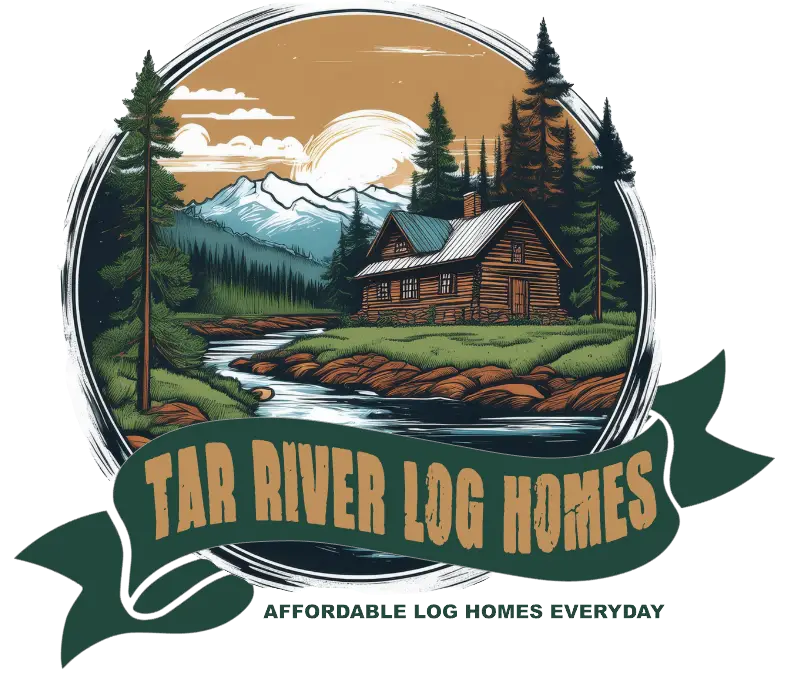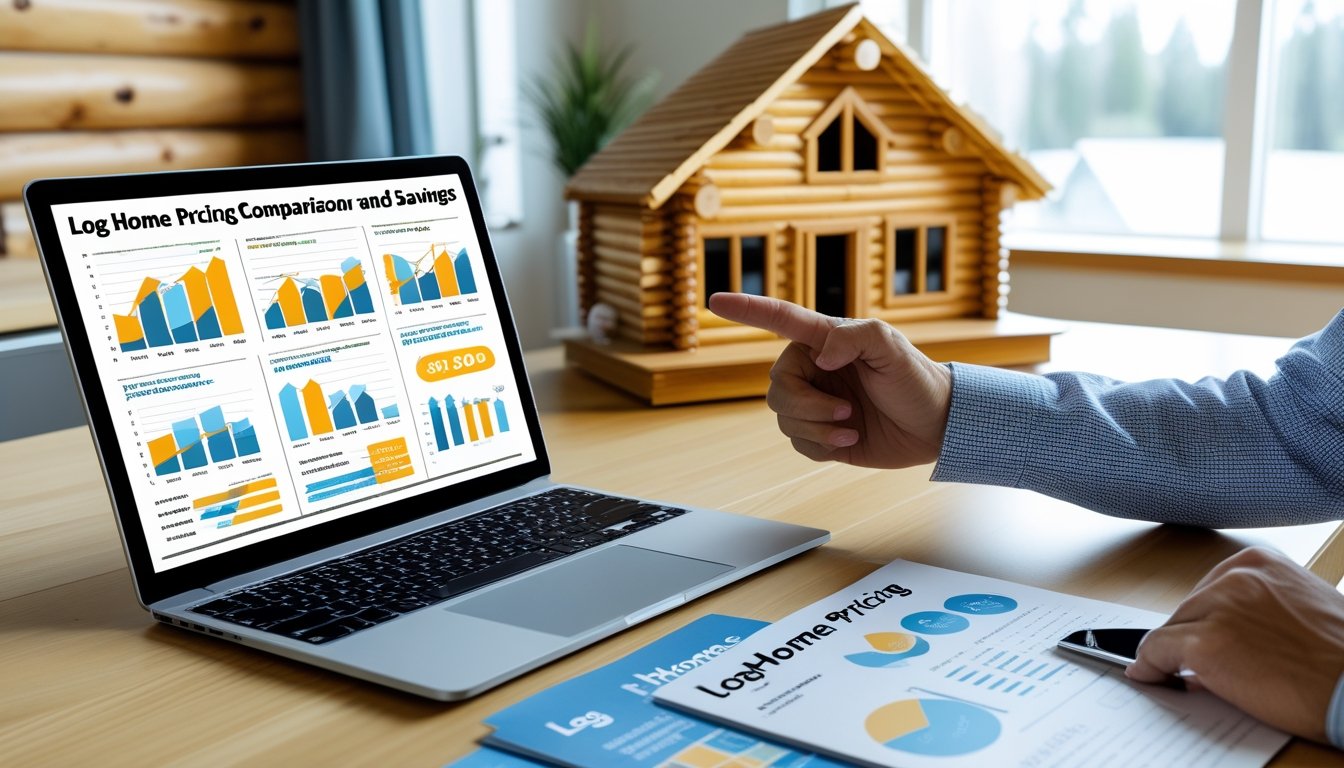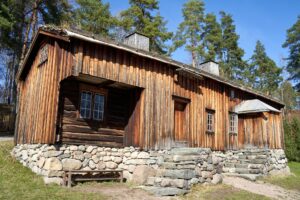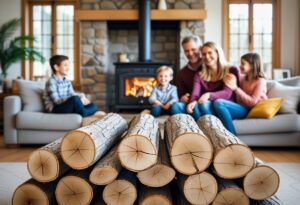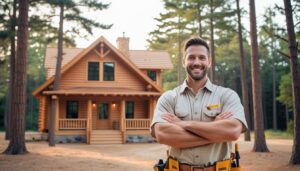If you’re thinking about building a log home, you’re probably wondering—how much will it actually cost? Log home prices swing a lot depending on materials, design, and where you’re buying. However, knowing these differences might just save you a small fortune.
Once you get the main factors, it’s a lot easier to compare prices and dodge overpaying. At Tar River Log Homes, we try to keep things simple. Best quality logs and materials at wholesale prices, no sneaky fees or padded costs—just honest numbers, so your money goes further.
This guide breaks down the pricing details, allowing you to make informed choices without second-guessing.
Understanding Log Home Pricing
Figuring out what really affects the price of a log home makes budgeting less of a headache. Style, materials, labor—they all matter. If you’re clear on these, you’re less likely to get blindsided.
What Drives the Cost of Log Homes
The biggest price factors? The type of logs, overall size, and your build location. High-quality logs cost more up front but tend to last much longer. Bigger homes need more of everything and take longer to build, so labor jumps too.
Then there’s land prep, permits, and getting utilities hooked up. Building way out in the sticks can mean extra fees for hauling wood and hiring contractors. Even the weather or time of year can mess with your timeline and bump up labor costs.
Types of Log Homes and Their Price Ranges
There are a few main log home types, and they’re not all priced the same.
- Solid Log Homes: Built from whole logs stacked up. Usually runs $150–$250 per square foot.
- Log Cabin Kits: Pre-cut panels you put together yourself or hire out. Think $50–$150 per square foot.
- Timber Frame with Log Siding: Frame house with log siding, $100–$200 per square foot.
What you choose comes down to your budget and how much you want to do yourself. Choose options that balance durability, code compliance, and budget.
Cost Ranges By Build Type (Reality Check)
Guides by Home Advisor and Angi estimate that log cabin builds cost around $125–$175/sq ft on average, with high-end custom builds being higher. Smaller cabins can start at around $25k; 1,500 sq ft builds often exceed $250k, depending on the specifications.
Prefab approaches vary, commonly ranging from $150 to $300 per square foot. Use these ranges to sanity-check quotes.
Cost Breakdown: Materials, Labor, and More
Materials eat up about 50–60% of your total cost. That’s logs, roofing, windows, and doors. Eastern white pine logs? Super popular for being tough and not breaking the bank.
Labor is another 20–30%. Skilled folks cut, fit, and finish the logs. If you’re handy, a kit might save you some cash on labor. Permits, site work, utilities, and design plans usually add another 10–20% on top.
Comparing Log Home Packages
When you’re looking at log home packages, it’s smart to know what’s actually included and how much you’ll need to do yourself. Some packages are all-in, while others just give you the basics. That difference can really matter, depending on your skills and wallet.
Complete Kit vs. Shell Only
A Complete Kit gives you pretty much everything: logs, doors, windows, roofing, and sometimes even interior finishes. You get all the main parts in one go, so it’s quicker and less hassle. If you want a smoother build, this is the way.
A Shell Only package just covers the exterior—walls, roof frame, maybe the floor. You’re on your own for the inside stuff like drywall, wiring, plumbing. It’s cheaper up front, but you’ll have more work and extra expenses later.
Complete kits are great if you want the process to be easy. Shells are good if you want to customize the inside or save by doing more yourself.
Turnkey Options
Turnkey means the builder takes care of everything—permits, utilities, interiors, and the lot. You basically just move in. It costs more, but you skip the headaches.
If you’re not into building or chasing down contractors, turnkey is a relief. If you’re handy or want to save, you might skip it and take on more yourself. Many suppliers and builders offer flexible scopes so you only pay for what you need.
Pre-Cut vs. Custom Designs
Pre-Cut Kits come with logs cut to match a specific plan. That keeps costs down and makes assembly faster. These kits are tried-and-true, with clear instructions—perfect for first-timers or DIY folks.
Custom Designs let you tweak the plan—size, shape, style, whatever fits your vision. It’ll take more time and money, but you get exactly what you want.
If you’re watching your budget or want to build fast, pre-cut is probably best. If you want something unique, custom is the way to go.
Regional Price Differences
Where you build your log home can change the price a lot. Some states charge more for materials and labor. Whether you’re out in the country or near a city matters too.
Price Trends by State
Log home prices shift by state because of local wood supplies, labor rates, and demand. States with tons of forests, like North Carolina or Oregon, usually have cheaper materials. In places like parts of Florida, where logs are rare, prices jump thanks to shipping and scarcity.
Labor rates are all over the place. High-wage states drive up your total, while others help keep it in check.
Here’s a quick peek:
| State | Material Cost | Labor Cost | Total Price Trend |
| North Carolina | Low | Moderate | Affordable, steady |
| Colorado | Moderate | High | Higher due to labor |
| Florida | High | Moderate | Higher because of materials |
A trusted company tries to keep prices fair wherever you are, so you’re not paying extra just because of your zip code.
Rural vs. Urban Locations
Building out in the country? Land’s cheaper, and local labor might be easier to find. But getting logs and supplies delivered way out there can rack up fees. Cities are easier for deliveries, but land, labor, and permits usually cost more.
What’s more important—saving on land and labor, or being closer to town? It’s your call. Use clear, line-item quotes to compare costs across locations.
Log Species and Quality Impact on Pricing
The type of wood and its quality really change your log home’s price. Different species and grades come with their own costs. Knowing this stuff helps you pick the best value for your needs and budget.
Popular Wood Types and Their Costs
Some woods are favorites for log homes because they’re tough and don’t cost a fortune. Eastern White Pine is a go-to—affordable, easy to work with, and looks good. Pine logs are usually cheaper per foot than hardwoods.
Cedar and Douglas Fir? Stronger, better at handling moisture, but pricier—cedar can cost 20–30% more than pine. Oak and Hickory are tough but rare, and you’ll pay up to three times the price of pine. Choose your wood according to climate, durability, and budget.
Quality Grades: How They Affect Price
Logs come in different grades, mostly based on knots, straightness, and drying method. Higher grades have fewer knots and are straighter—easier to build with and just look better. They cost more, since they take more work to produce.
Lower grades have more knots and odd shapes. They’re cheaper, but you might be fixing and maintaining more down the road.
Kiln-dried logs cost more than air-dried, but they shrink less, and pests don’t love them as much. If you want a home that lasts and doesn’t need much upkeep, higher grades and kiln-dried logs are worth it.
You can save by balancing wood type and grade—no need to sacrifice style or durability.
Construction Methods and Pricing Variations
How your logs are made and how your site gets prepped can really move the price needle. Understanding these details helps you see where your cash is actually going.
Handcrafted vs. Milled Log Construction
Handcrafted logs get shaped by hand, giving your home a one-of-a-kind, rustic vibe. It’s slower and needs more skill, so the price goes up. The logs aren’t all the same size or shape, which adds charm but takes extra work to assemble.
Milled logs are machine-cut to fit together perfectly. They’re quicker to build with and usually cheaper than handcrafted. You get straight edges, consistent sizes, and less hassle during assembly. If you want to save time and money, milled logs are a solid bet.
Milled logs often balance price, speed, and consistency for many projects.
Assembly and Site Prep Costs
Building a log home isn’t just about stacking logs. You’ve got to prep the land—clear trees, level the ground, pour a foundation. If your lot’s tricky, costs can spike fast.
Assembly costs depend on your log style and how complicated your plan is. Simpler designs are cheaper. Fancy corners or extra features? More time, more money. Hiring pros gets it done faster, but you’ll pay more up front.
You can cut costs by doing some work yourself or sticking with simpler plans.
Hidden Costs in Log Home Building
Building your dream log home means thinking past just the logs and kits. There are extra fees and work that sneak up on you if you’re not careful.
Permitting and Inspections
Before you even break ground, you’ll need permits from your local government. Costs swing a lot—could be a few hundred bucks, could be thousands. Permits cover zoning, building approvals, and environmental stuff.
Inspections come with the territory. Local officials check your work at different stages. If you don’t pass, you might face delays and extra costs for fixes. Budget for multiple inspections, just to be safe.
Getting permits and passing inspections isn’t just red tape—it keeps your build legal and up to code.
Utility Hookups and Land Preparation
Your land probably isn’t build-ready. You’ll need to clear trees, level things out, and dig foundations—all of which can add thousands to your bill.
Hooking up water, electric, and septic? That’s another chunk of change. If your spot’s remote, expect higher costs for trenches, pipes, wiring, and permits. Get a solid estimate for land prep and utilities before you buy materials.
Financing Your Log Home
Building a log home takes some serious money and planning. Knowing your loan options and how to budget keeps things under control. If you’re prepared, you’ll have fewer surprises and more say over your spending.
Typical Loan Options
Most people go for construction loans to cover the building phase. These work like a credit line, releasing funds as you hit milestones. Once you’re done, it usually flips into a standard mortgage with monthly payments.
You might also look at FHA loans—lower down payments, but more hoops to jump through. Or maybe a USDA home loan if you’re building rural—no down payment, which is nice.
Heads up, some banks see log homes as a bit unusual. That might mean more paperwork or a higher rate. Getting pre-approved and finding a lender who knows log homes makes things smoother.
Budgeting and Price Planning
Add up everything—not just the house. Land, permits, utilities, site work, interior finishes, landscaping. It all counts.
Break your budget down:
- Land and site prep: 20%
- Materials (logs, roofing, windows): 50%
- Labor and permits: 20%
- Contingency fund: 10%
Always stash a little extra for surprises. A reliable publisher keeps pricing upfront, so you know what your materials cost. That makes it easier to adjust as you go—no big shocks.
How to Get Accurate Price Estimates
If you want a real price estimate for your log home project, you’ll need to get specific about what you want. It helps to work with builders who actually listen to your budget and needs.
Requesting Detailed Quotes
Ask for a clear breakdown of all costs when you request a quote. That means the price of logs, delivery, customization, and extras like roofing or insulation.
Don’t settle for vague stuff like “miscellaneous fees.” If each quote lists the same details, you can line them up and see exactly what you’re paying for.
Check if the quote includes things like taxes or permits. These can sneak up on you and throw off your budget.
Working With Log Home Builders
Pick builders who lay it all out—no hidden fees or weird sales talk. A trusted company keeps things transparent.
Ask how they price upgrades or custom changes. Some charge a flat rate, others go by the hour. It’s good to know up front so you don’t get surprised.
Make sure the builder’s got experience with the style you want. The right crew can spot ways to save money but still give you a solid, good-looking home.
Ways to Save on Log Home Construction
Building a log home isn’t cheap, but you don’t have to break the bank, either. You can save by tackling some projects yourself and picking features that fit your budget.
DIY and Sweat Equity
Doing some work yourself? That can really cut costs. If you’re up for staining logs, installing floors, or handling some finishing touches, you’ll save on labor. You don’t need to be a pro—just careful and willing to put in the time.
Of course, some jobs (like plumbing or wiring) need a professional. But if you take on the simpler stuff, you could save thousands. Pre-cut, labeled materials reduce prep time and waste on site.
Be honest about what you can do, though. Don’t rush it or bite off more than you can chew—mistakes can get expensive. Sweat equity is all about trading your own effort for savings.
Choosing Cost-Effective Features
Not every upgrade is worth the price. Stick to materials and designs that look good and last, but don’t cost a fortune. Standard windows and doors, for example, are way cheaper than custom ones.
Eastern White Pine logs keep prices down and still last. Simple roof shapes—like gable or shed—are easier on the wallet than fancy designs.
Cutting back on interior customization can help, too. Open floor plans and standard finishes save time and money. Spend more where it matters, like on good insulation, so you don’t pay more to fix things later.
Log Home Pricing Comparison Table
Log home prices swing a lot depending on materials, size, and how custom you want to go. Here’s a table to make sense of it:
| Log Home Type | Price Range (per sq. ft.) | Materials | Notes |
| Basic Log Home Kit | $25 – $40 | Eastern White Pine Logs | Good for budget builds |
| Mid-Range Custom Builds | $40 – $60 | Kiln-dried, custom-cut logs | More design choices, better fit |
| High-End Custom Homes | $60+ | Premium logs, extras included | Full custom plans and a luxury feel |
Tar River Log Homes keeps affordability front and center. You get quality logs at wholesale prices—no nonsense.
You can save by picking your own plan and only customizing what you actually want. That cuts out waste and keeps your budget on track.
They’ve got a 105% price guarantee, so you’ll know you’re getting the best deal on log home materials. You pay for what you want—nothing extra.
Quick rundown:
- Basic kits: lowest cost
- Mid-range: better quality, more options
- High-end: custom everything
Use this to figure out where your dream home fits. Honest prices mean you spend your time building—not second-guessing.
Ready to take the next step? Request a detailed pricing comparison and start planning today.
Frequently Asked Questions
Building a log home? There’s a lot to think about—costs, what drives them up, and what you’ll actually pay. Here’s what folks ask most:
What is the average cost per square foot for a log home?
The typical price runs $125 to $200 per square foot. It depends on materials, where you’re building, and labor.
How do the prices of log home kits vary based on square footage?
Smaller kits usually cost more per square foot, thanks to fixed production costs. Bigger kits spread those costs out, so the price per foot drops a bit.
What factors most significantly affect the price of a log cabin?
Log quality, home size, and how complex the design is—those matter most. Foundation, labor, and site work can also swing your final cost.
Can you provide a cost comparison for a 3-bedroom log cabin kit?
A 3-bedroom kit from Tar River Log Homes often starts around $45,000. Go bigger or more custom, and you’re looking at $70,000 or more.
Are there any additional expenses to consider when building a log home?
Definitely, site work, foundation, utilities, permits, and finishing the inside all add up beyond just the kit price.
How does the resale value of log homes compare to conventional homes?
Log homes usually hold their value pretty well, as long as you look after them. They might take a bit longer to sell, though, and honestly, they seem to attract more interest on wooded or rural lots—maybe it’s that whole cozy cabin vibe.
